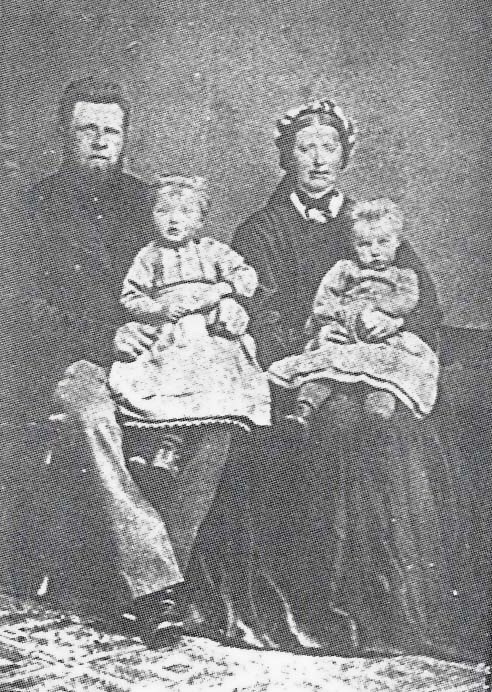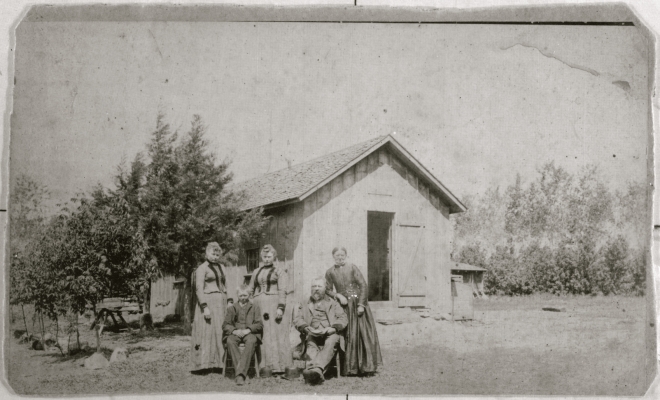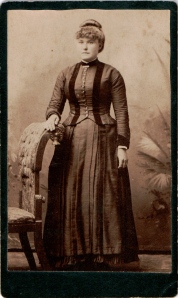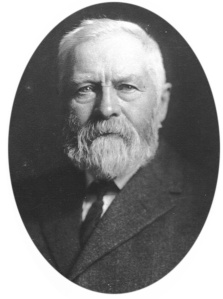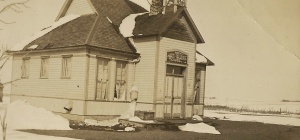There can be no question that Christina Marie (Schmidt) Nelson was a strong and capable woman.
Born in Skrydstrup, Gram, Haderslev, Denmark on 11 October 1868, to Jens Madsen Schmidt and Anne Bramsen, Christina immigrated to America with her parents and older sister when she was just twenty months of age. A dugout on a homestead in Dakota Territory was her first home in America; it was from this homestead in Bon Homme County that she spent long hours tending her family’s cattle, experienced devastating prairie fires and blizzards, witnessed interactions with displaced Native Americans, and even once encountered General George Armstrong Custer when he stopped for a drink of water. She was fortunate enough to attend a one-room log schoolhouse through eighth grade, and, in 1889, when she was twenty-one, she married her neighbor and fellow Danish immigrant Frederick Nelson.
Over the course of the next twenty years, Christina gave birth to nine healthy children: Anna Sophie (1891), Julia Marie (1892), Ole James (1894), Andrea Mathilda (1896), Louise Christine (1899), Helena Margaret (1900), Mary Magdalene (1904), Frederick Andrew (1908), and Myron Alvin (1910). Education was of apparent importance to Christina and Fred, as he was known; although their oldest son attended school only through eighth grade, destined to become a farmer like his parents before him, their younger sons and daughters all attended school at least until the age of sixteen. They even saw to it that their four youngest daughters had the opportunity to attend a “normal school” in nearby Springfield, South Dakota, where they received the necessary training to become schoolteachers.

A formal portrait of the Nelson family was taken in July of 1912, likely in Yankton, which was not far from the family’s home in Lakeport; the girls sport bare forearms for the season, their fabric colors light and featuring gingham, stripes, and lace. Christina, while dressed in a dark gown, wears a white collar and whimsical crocheted flowers at her throat. As to the occasion for the photograph, it was not a milestone anniversary year—Christina and Fred would have celebrated their twentieth anniversary the previous spring. However, Christina perhaps realized that, at forty-three, her childbearing years were behind her and now was the time to have a portrait taken of the entire family all together. Furthermore, as her eldest daughter had married in March of 1912, having her first child leave the nest might also have sparked sentimentality and a wish to document the fact that, at least for a short while, all nine Nelson children had been under one roof.
Christina and Fred would go on to celebrate their twenty-fifth anniversary in 1916, but two years later, a matter of weeks after her fiftieth birthday, Christina would be dealt several harsh blows in short succession. First, Spanish Influenza hit the household, and then, in a turn of events that shocked both the family and their wider community, she lost Fred to suicide, and, one month later, daughter Andrea to undetermined medical circumstances.
Christina persevered. She faced another trial when her father died the following spring, but it was a blessing that her eldest son was home from his service in the Great War and able to help manage the family farm while she continued to raise her two youngest sons. She continued to live on the farm with support from her sons well into her old age; even in 1950, when she was eighty-two, the census reported that she was still “keeping house” for her three bachelor sons. It was at this farmhouse that her children and grandchildren frequently gathered to celebrate birthdays and holidays.
Christina died on 23 January 1961 at the age of ninety-two and is buried alongside her husband and three of their nine children at the Elm Grove Cemetery in Yankton County, South Dakota. A brief biography included in a local history book several years prior had noted, “Mrs. Nelson is well-known by her many friends and relatives as a person who always has a warm welcome hand extended to all those who call at her home. Even today, at the age of eighty-five, she is active with her household duties and retains an active interest in what is going on about her. She is cordial and sympathetic with the many young people who come her way. She is truly one of Dakota’s pioneer mothers who still looks ahead and enjoys her home and family.”
Copyright © 2022 Melanie Frick. All Rights Reserved.
Continue reading